Experimental Study on Fluidization Behaviors of Wet Rice Threshed Materials with Hot Airflow
Abstract
:1. Introduction
2. Materials and Methods
2.1. Threshed Rice Mixture Samples
2.2. Experimental
2.2.1. Fluidized Bed Setup
2.2.2. Hot Airflow Cleaning Device
2.3. Experimental Procedure
2.3.1. Fluidization Test
2.3.2. Hot Airflow Cleaning Test
2.4. Statistical Calculations
3. Results and Discussion
3.1. Fluidization Characteristics of Wet and Dry Rice Threshed Mixture
3.1.1. Minimum Suspension Velocity and Fastest Suspension Time
3.1.2. Flow State
3.1.3. Dispersion Degree of Wet Rice Threshed Mixture
3.1.4. Surface Water Content
3.2. Hot Airflow Cleaning Test
4. Conclusions
- With the increase in temperature, the minimum suspension velocity and the fastest suspension time decreased gradually. The minimum suspension velocity of rice grains and short stems increased slightly with inlet airflow up to the critical temperature, equal to 40 °C, and then increased markedly with temperature. The fastest suspension time of the wet rice threshed mixture was less than 2 s when the temperature increased to 60 °C. According to the observed flow state of the wet rice threshed mixture, the agglomerations formed by rice grains, short stems and light impurities are difficult to break into discrete particles under the normal temperature airflow. The lower half of the agglomerate was the first to disperse and the short stems began to pass through the rice grain layer with the increasing temperature. When the gas temperature was about 60 °C, rice grains and impurities were effectively separated.
- The trends in the pressure drop and surface moisture content of light impurities were the same: both decreased gradually with the increase in inlet gas temperature. As the temperature increased to 60 °C, the surface moisture content of the wet particles decreased to a lesser extent, which explains the dispersion phenomenon in the fluidization process.
- The adhesion mass on the front of the screen surface can be reduced with the increase in the inlet airflow temperature. However, it is little affected by the vibration frequency. When the airflow temperature and vibration frequency were 50 °C and 5 Hz, respectively, the accumulation mass was less than 220 g. Another beneficial effect of increasing the inlet gas temperature is that the screen sieve was heated and the adhesion was reduced.
- In future work, more cleaning parameters, such as airflow velocity, louvre screen opening and vibration amplitude, will be considered to study the dispersion characteristics of the wet rice threshed mixture in the air-and-screen cleaning unit.
Author Contributions
Funding
Institutional Review Board Statement
Informed Consent Statement
Acknowledgments
Conflicts of Interest
References
- Liu, Y.B. Study on Performance of Concentric Threshing Device with Multi-Threshing Gaps for Rice Combines. Agriculture 2021, 11, 1000. [Google Scholar] [CrossRef]
- Bag, M.K.; Basak, N.; Bagchi, T.; Masurkar, P.; Ray, A.; Adak, T.; Jena, M.; Rath, P.C. Consequences of Ustilaginoidea virens infection, causal agent of false smut disease of rice, on production and grain quality of rice. J. Cereal Sci. 2021, 100, 103220. [Google Scholar] [CrossRef]
- Bagchi, T.B.; Chattopadhyay, K.; Sivashankari, M.; Roy, S.; Kumar, A.; Biswas, T.; Pal, S. Effect of Different Processing Technologies on Phenolic Acids, Flavonoids and Other Antioxidants Content in Pigmented Rice. J. Cereal Sci. 2021, 100, 103263. [Google Scholar] [CrossRef]
- Ni, G.; Qin, Y.; Han, K. Innovative Cleaning Technology of Rice Combine Harvester for All-weather Harvesting. J. Agric. Equip. Veh. Eng. 2019, 57, 173–174. [Google Scholar]
- Chen, C.; Fun, J.; Chen, Z.; Ren, L.Q. Effect of vibration parameters of vibrating screen for harvester on adhesion characteristics of threshed mixtures with different moistures. J. Trans. Chin. Soc. Agric. Eng. 2019, 35, 29–36. [Google Scholar]
- Cheng, C.; Fu, J.; Tang, X.; Chen, Z.; Ren, L.Q. Effect of vibration mode on the interface adhesion law of rice threshed mixtures. J. Jilin Univ. (Eng. Technol. Ed.) 2019, 49, 1228–1235. [Google Scholar]
- Tang, Z.; Li, Y.; Li, H.; Xu, L.; Zhao, Z. Analysis on the eddy current of the air-and-sieve cleaning device. Trans. Chin. Soc. Agric. Mach. 2010, 41, 62–66. [Google Scholar]
- Liang, Z.W. Development and testing of a multi-duct cleaning device for tangential-longitudinal flow rice combine harvesters. Biosyst. Eng. 2019, 182, 95–106. [Google Scholar] [CrossRef]
- Leng, J.; Li, X.; Du, Y.; He, S.; Ding, X.; Niu, X. Analysis and optimization of internal flow field of cleaning device of single longitudinal axial flow grain combine harvester. Trans. Chin. Soc. Agric. Eng. 2020, 36, 39–48. [Google Scholar]
- Ning, X.; Jin, C.; Yin, X. Research status and development trend of air-screen cleaning device for cereal combine harvesters. J. Chin. Agric. Mech. 2018, 39, 5–10. [Google Scholar]
- Ma, Z.; Li, Y.-M.; Xu, L.-Z. Theoretical analysis of micro-vibration between a high moisture content rape stalk and a non-smooth surface of a reciprocating metal cleaning screen matrix. Biosyst. Eng. 2015, 129, 258–267. [Google Scholar] [CrossRef]
- Li, Y.; Ma, Z.; Xu, L. Tribological characteristics of adhesion materials on cleaning sieve of rape combine harvester. Trans. Chin. Soc. Agric. Mach. 2010, 41, 54–57. [Google Scholar]
- Ma, Z. Study on Friction and Particles Motion of Bionic Anti-Clogging Screening Process in Agricultural Materials; Jiangsu University: Zhengjiang, China, 2015. [Google Scholar]
- Ma, Z.; Li, Y.-M.; Xu, L.-Z. Micro flow field on adjacent screen of bionic non-smooth cleaning screen. Trans. Chin. Soc. Agric. Mach. 2011, 42, 74–77. [Google Scholar]
- Cheng, C.; Fu, J.; Chen, Z.; Ren, L. Design and Experiment on Modified Sieve with Coating of Rice Harvester. Trans. Chin. Soc. Agric. Mach. 2020, 51, 94–102. [Google Scholar]
- Xu, L.; Ma, Z.; Li, Y. Wettability of rape cleaning screen surface by laser-texture. Trans. Chin Soc. Agric. Mach. 2011, 42, 168–171. [Google Scholar]
- Cheng, C.; Fu, J.; Tang, X.; Chen, Z.; Ren, L. Heating Anti-adhesion Experiments of Jitter Plate of rice Harvesting Machinery. Trans. Chin. Soc. Agric. Mach. 2019, 50, 110–111. [Google Scholar]
- Chen, N.; Huang, D.; Chen, D.; Tian, X.; Zhang, J. Theory and experiment on non-uniform air-flow cleaning of air-screen cleaning unit. Trans. Chin. Soc. Agric. Mach. 2009, 40, 73–77. [Google Scholar]
- Li, H.; Li, Y.; Gao, F.; Zhao, Z.; Xu, L. CFD–DEM simulation of material motion in air-and-screen cleaning device. Comput. Electron. Agric. 2012, 88, 111–119. [Google Scholar] [CrossRef]
- Bai, G.; Ta, N.; Zhu, Y. Experimental study on the grain suspension velocity by using high-speed camera system technology. Mogolia Agric. Univ. 2012, 33, 167–170. [Google Scholar]
- Hou, H.M.; Cui, Q.L.; Guo, Y.M.; Zhang, Y.Q.; Sun, D.; Lai, S.T.; Liu, J.L. Design and test of air-sweeping suspension velocity testing device for cleaning threshed materials of grain and oil crops. Trans. Chin. Soc. Agric. Eng. 2018, 34, 43–49. [Google Scholar]
- Chen, H.; Huang, B. Research on Technique to Clean paddy by Pulsation Fluidization. Mod. Agric. Equip. 2013, 4, 37–40. [Google Scholar]
- Xu, H.; Zhong, W.; Yu, A.; Yuan, Z. Spouting Characteristics of Wet Particles in a Conical-Cylindrical Spouted Bed. Ind. Eng. Chem. Res. 2015, 54, 9894–9902. [Google Scholar] [CrossRef]
- Schneider, T.; Bridgwater, J. The stability of wet spouted beds. Dry. Technol. 1993, 11, 277–301. [Google Scholar] [CrossRef]
- Lehmann, S.E.; Hartge, E.U.; Jongsma, A.; de Leeuw, I.M.; Innings, F.; Heinrich, S. Fluidization characteristics of cohesive powders in vibrated fluidized bed drying at low vibration frequencies. Powder Technol. 2019, 357, 54–63. [Google Scholar] [CrossRef]
- Weber, S.; Briens, C.; Berruti, F.; Chan, E.; Gray, M. Agglomerate stability in fluidized beds of glass beads and silica sand. Powder Technol. 2007, 165, 115–127. [Google Scholar] [CrossRef]
- Xu, L.; Li, Y.; Li, H.; Zhao, Z. Development on test-bed of longitudinal axial threshing-separating-cleaning unit. Trans. Chin. Soc. Agric. Mach. 2009, 12, 76–79. [Google Scholar]
- Farahmandfar, R.; Farahmandfar, E.; Ramezani, A. Physical Properties of Rough Rice. Int. J. Food Eng. 2009, 5, 1–8. [Google Scholar] [CrossRef]
- Tabak, S.; Wolf, D. Aerodynamic properties of cotton seeds. J. Agric. Eng. Res. 1998, 70, 257–265. [Google Scholar] [CrossRef]
- Khoshtaghaza, M.H.; Mehdizadeh, R. Aerodynamic property of wheat kernel and straw materials. Agric. Eng. Int. CIGR J. 2006, 8, 1–10. [Google Scholar]
- Li, Y.; Xu, L.; Zhou, Y.; Li, B.; Liang, Z.; Li, Y. Effects of throughput and operating parameters on cleaning performance in air-and-screen cleaning unit: A computational and experimental study. Comput. Electron. Agric. 2018, 152, 141–148. [Google Scholar] [CrossRef]
- Carmen, K. Some physical properties of lentil seeds. J. Agric. Eng. Res. 1996, 63, 87–99. [Google Scholar] [CrossRef]
- Neto, P.S.; Cunha, F.O.; Freire, J.T. Effect of the presence of paste in a conical spouted bed dryer with continuous feeding. Dry. Technol. 2002, 20, 789–811. [Google Scholar] [CrossRef]
- Dong, R.; Xia, L.; Wang, H.; Jiao, D. 3-D CFD simulation of oil shale drying in fluidized bed and experimental verification. Oil Shale 2020, 37, 334–356. [Google Scholar] [CrossRef]
- Xu, H.; Zhong, W.; Shao, Y.; Yu, A. Experimental study on mixing behaviors of wet particles in a bubbling fluidized bed. Powder Technol. 2018, 340, 26–33. [Google Scholar] [CrossRef]

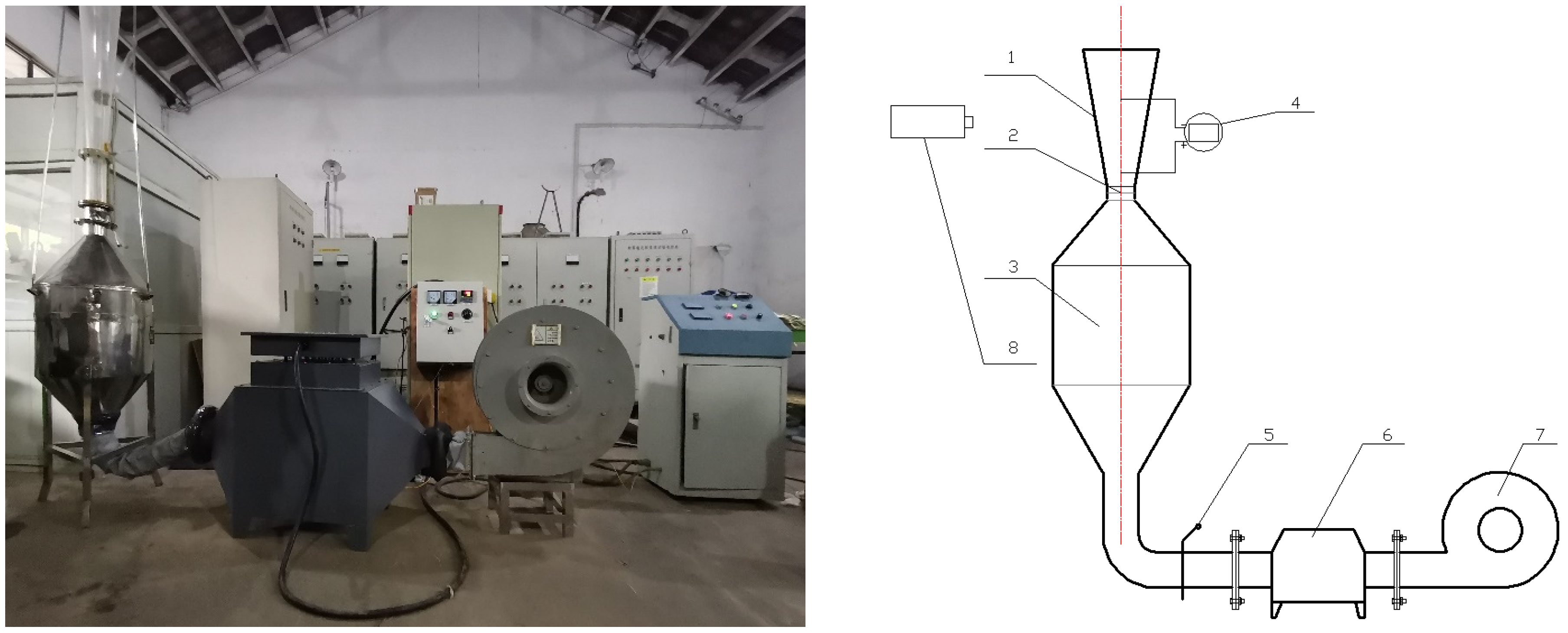
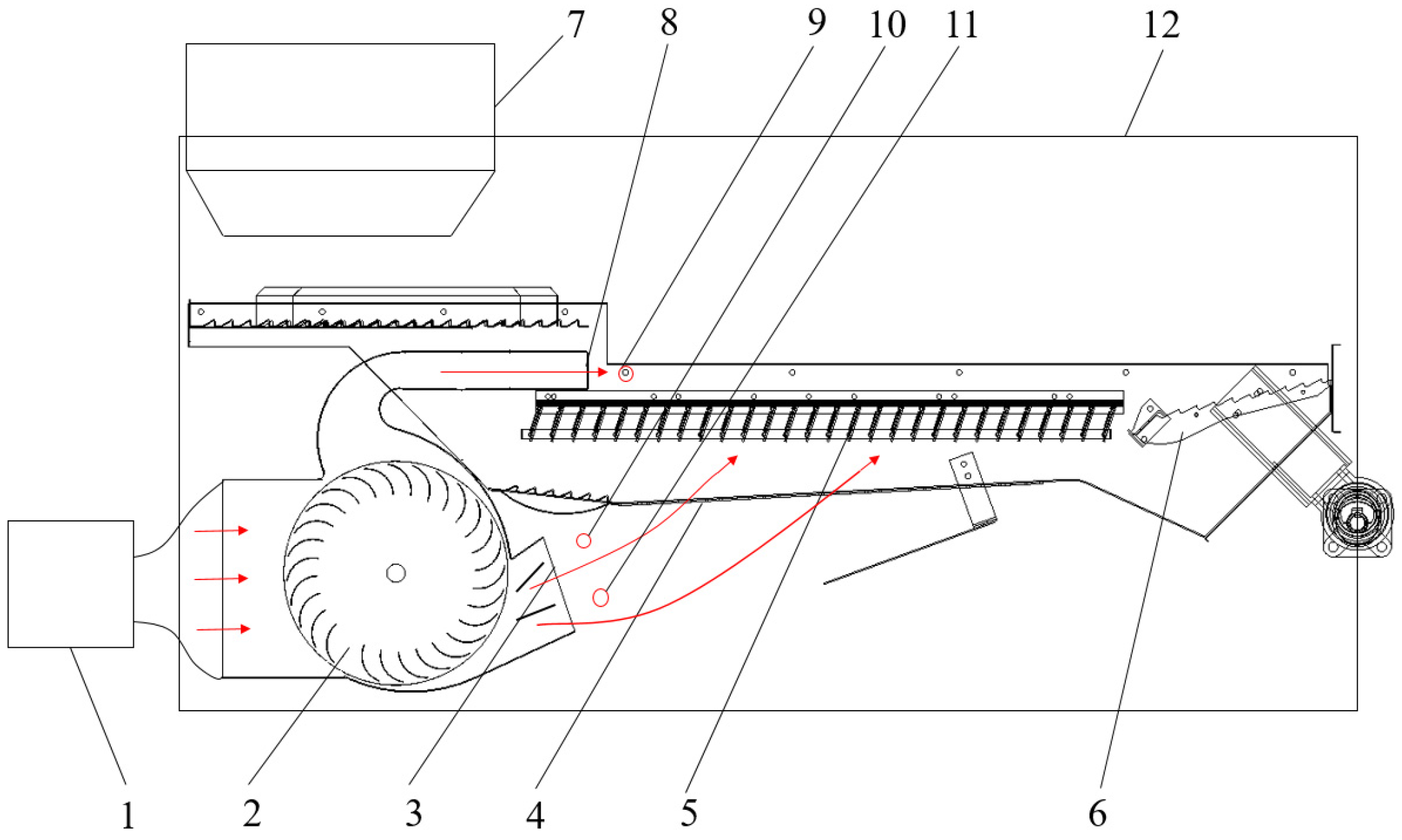
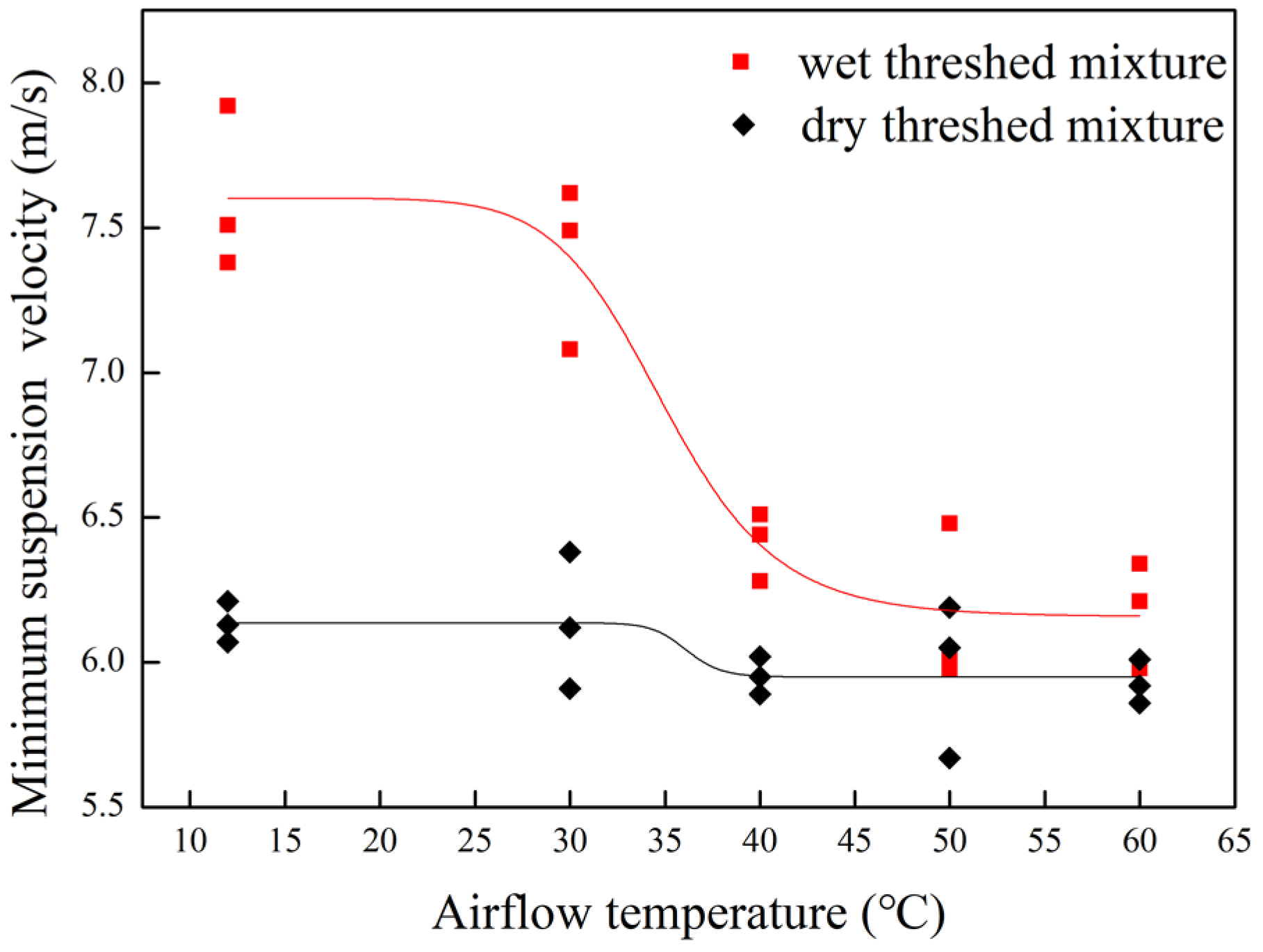
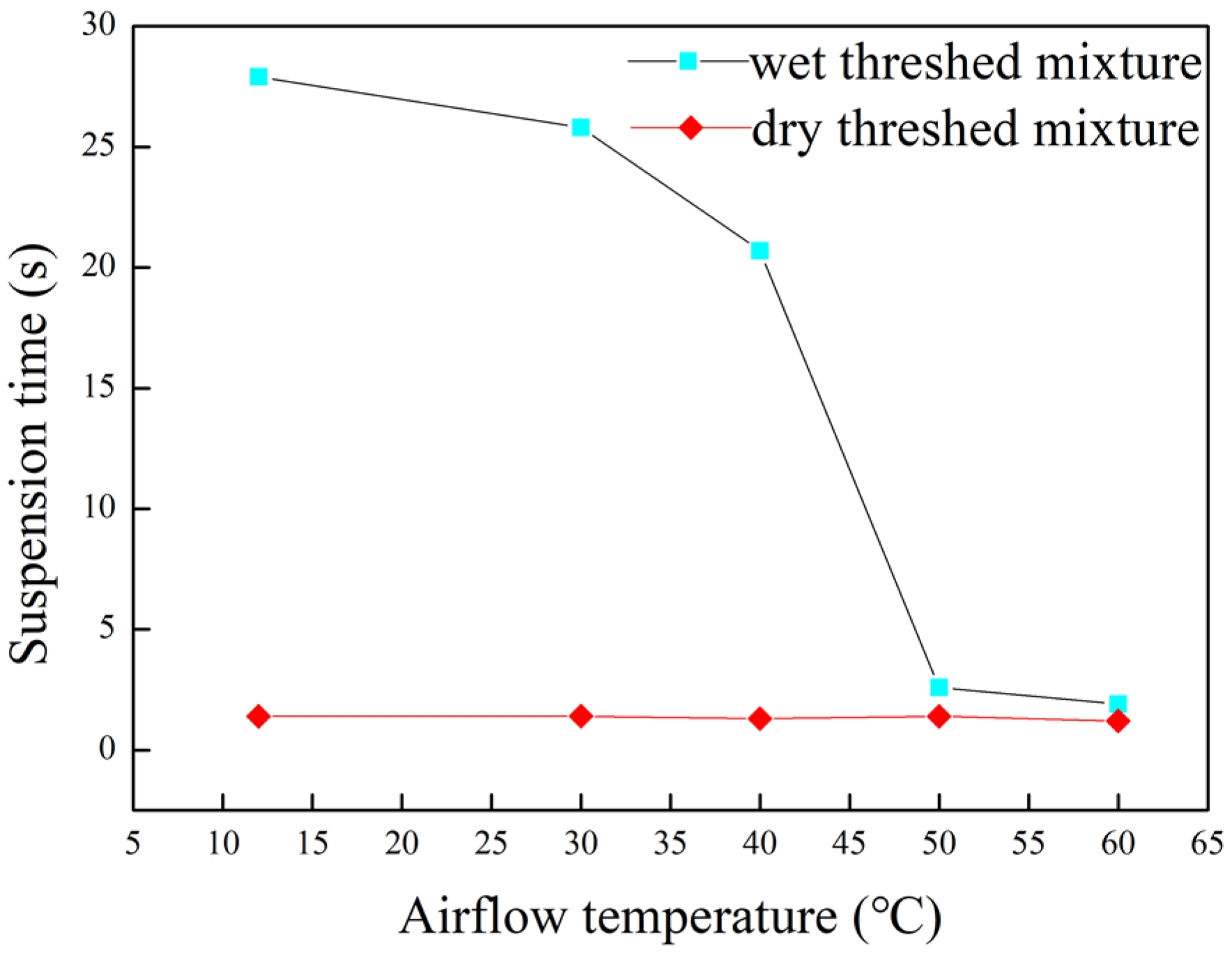
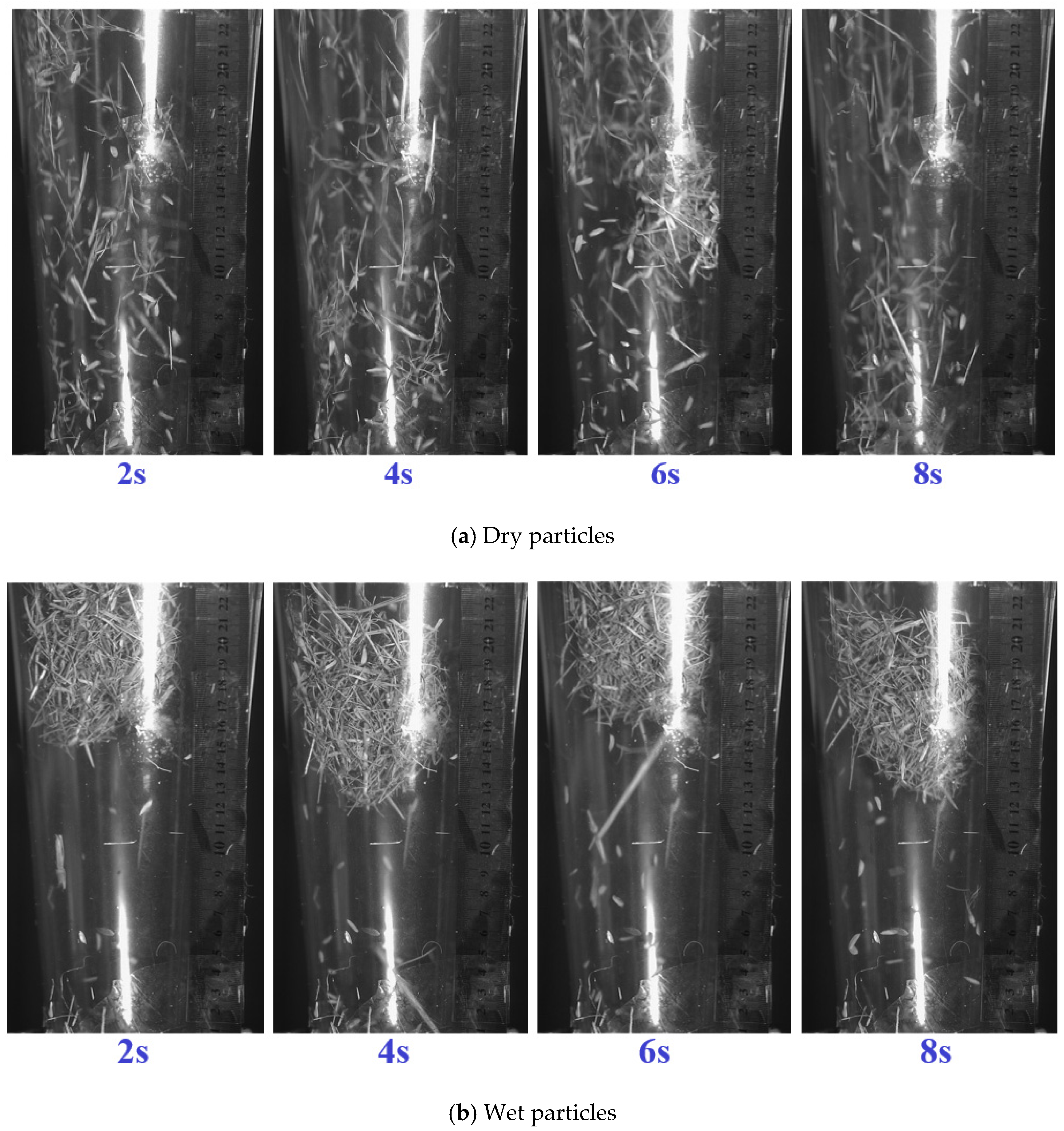
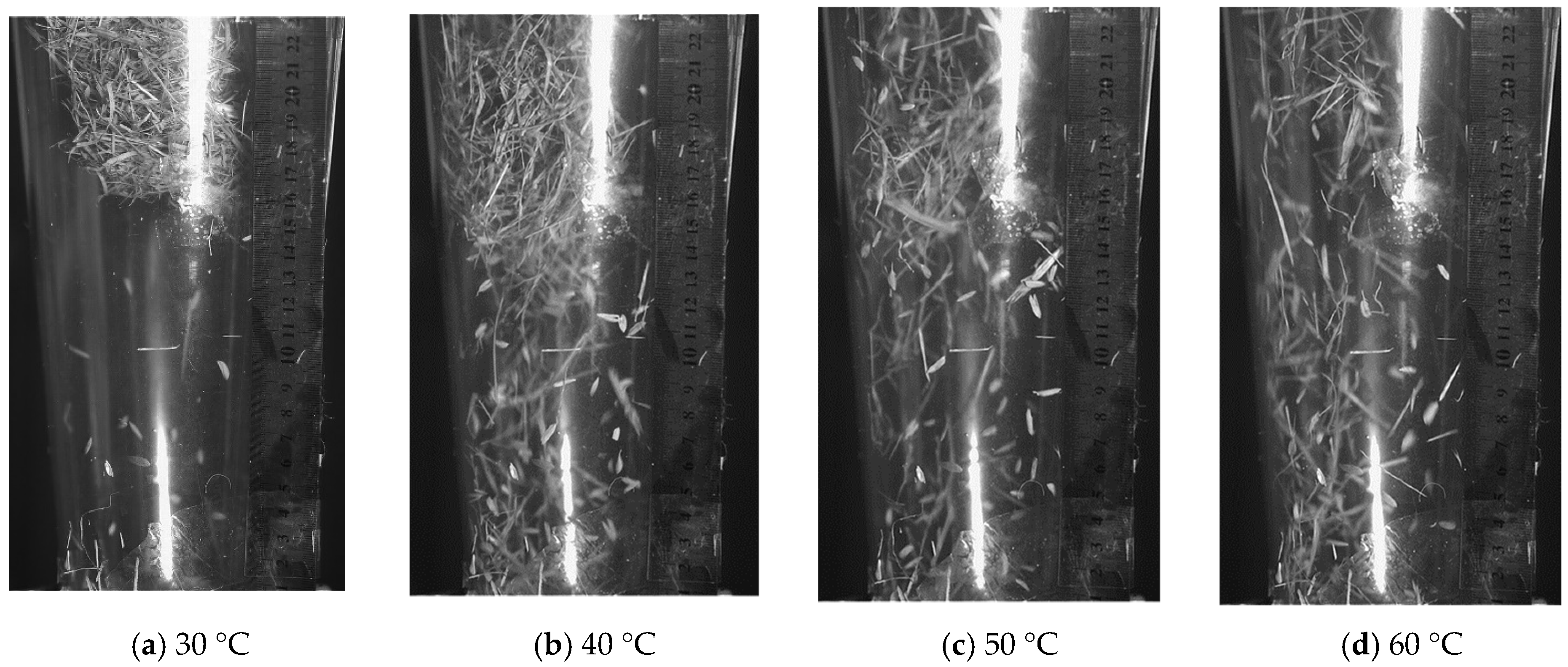

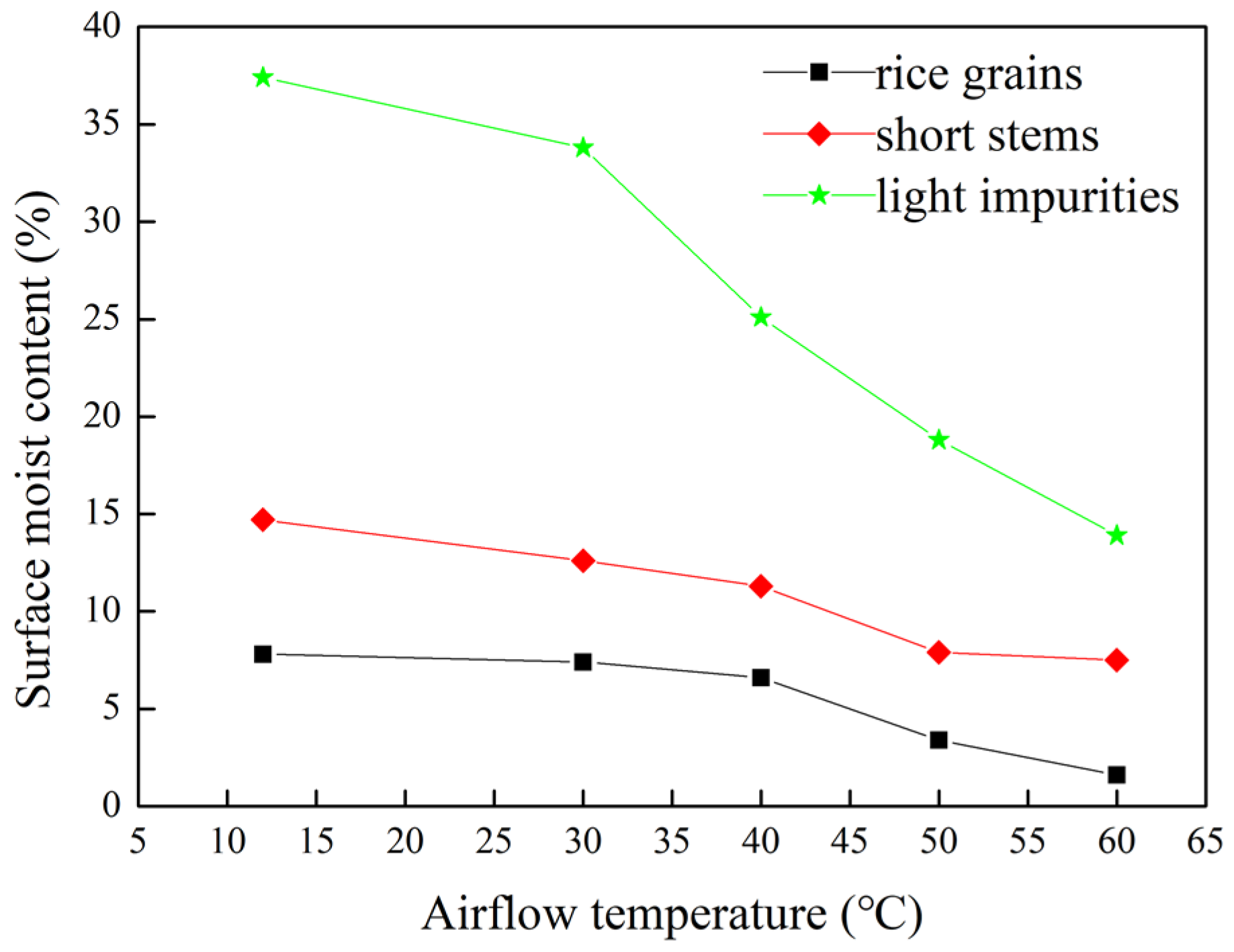
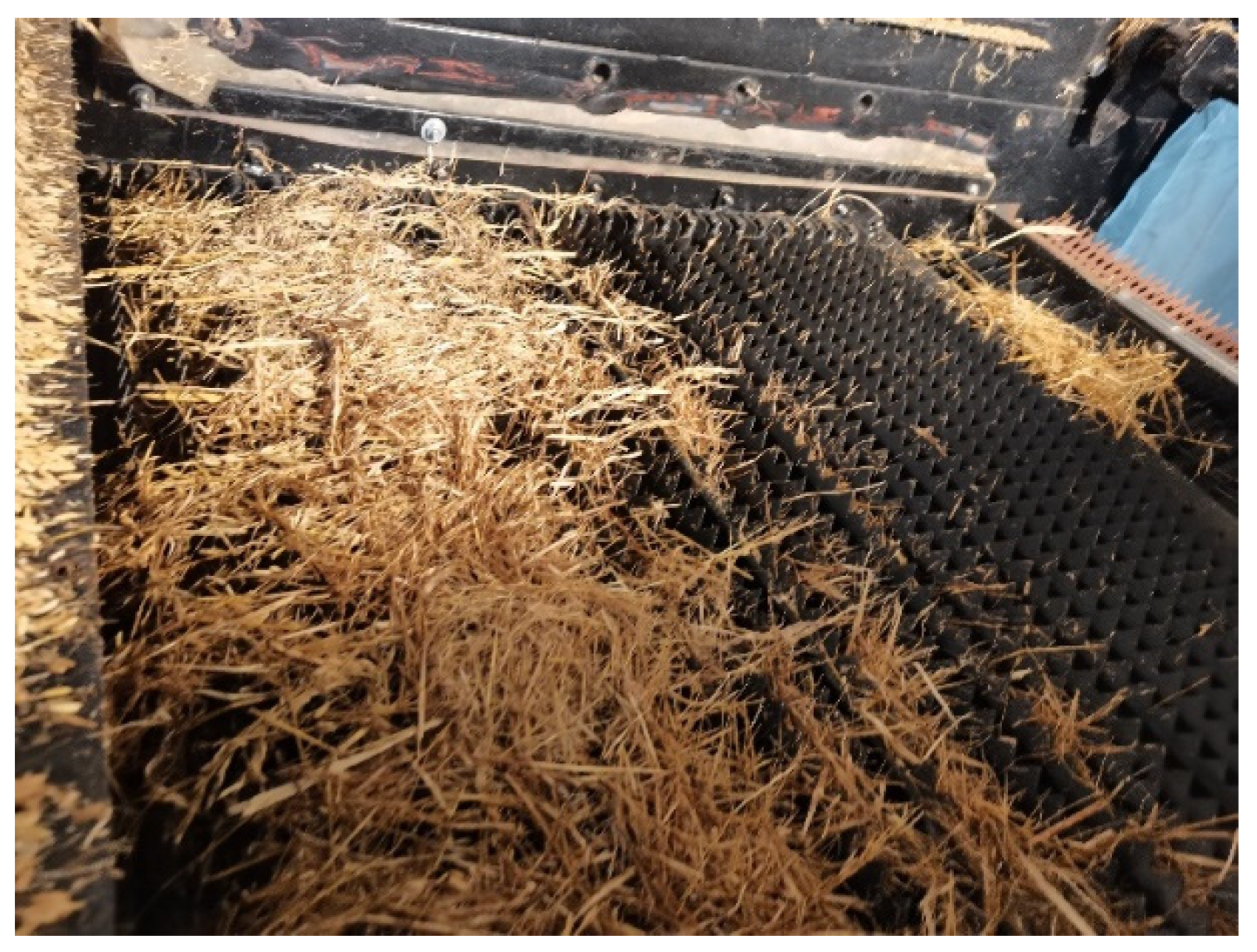
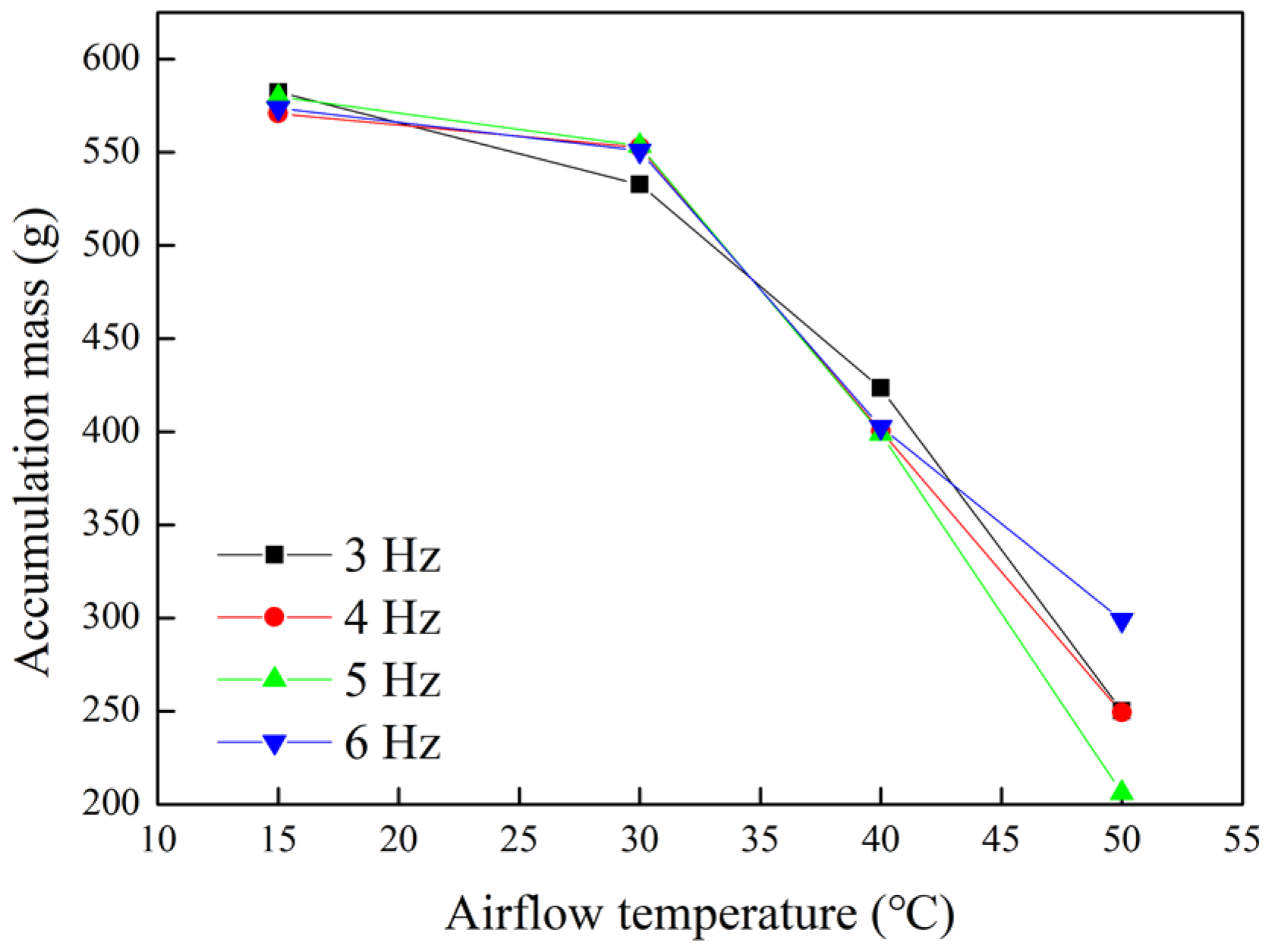
| Materials | Moist Content (%) | Length (mm) | Density (kg·m−3) | Diameter (mm) |
|---|---|---|---|---|
| Rice grains | 15.3 a/27.4 b | 9.2 | 1085 | - |
| Short stems | 40.6 a/79.2 b | 70.5 | 650 | 2.1–3.9 |
| Light impurities | 16.9 a/48.1 b | 48.9 | 220 | 0.3–0.7 |
| Operation Parameters | Value |
|---|---|
| Heating temperature (°C) | 15, 30, 40, 50 |
| Vibration frequency (Hz) | 3, 4, 5, 6 |
| Vibration amplitude (mm) | 30 |
| Fan speed (r/min) | 1000 |
Publisher’s Note: MDPI stays neutral with regard to jurisdictional claims in published maps and institutional affiliations. |
© 2022 by the authors. Licensee MDPI, Basel, Switzerland. This article is an open access article distributed under the terms and conditions of the Creative Commons Attribution (CC BY) license (https://creativecommons.org/licenses/by/4.0/).
Share and Cite
Zhang, T.; Li, Y.; Xu, L.; Liu, Y.; Ji, K.; Jiang, S. Experimental Study on Fluidization Behaviors of Wet Rice Threshed Materials with Hot Airflow. Agriculture 2022, 12, 601. https://doi.org/10.3390/agriculture12050601
Zhang T, Li Y, Xu L, Liu Y, Ji K, Jiang S. Experimental Study on Fluidization Behaviors of Wet Rice Threshed Materials with Hot Airflow. Agriculture. 2022; 12(5):601. https://doi.org/10.3390/agriculture12050601
Chicago/Turabian StyleZhang, Tao, Yaoming Li, Lizhang Xu, Yanbin Liu, Kuizhou Ji, and Sheng Jiang. 2022. "Experimental Study on Fluidization Behaviors of Wet Rice Threshed Materials with Hot Airflow" Agriculture 12, no. 5: 601. https://doi.org/10.3390/agriculture12050601
APA StyleZhang, T., Li, Y., Xu, L., Liu, Y., Ji, K., & Jiang, S. (2022). Experimental Study on Fluidization Behaviors of Wet Rice Threshed Materials with Hot Airflow. Agriculture, 12(5), 601. https://doi.org/10.3390/agriculture12050601






